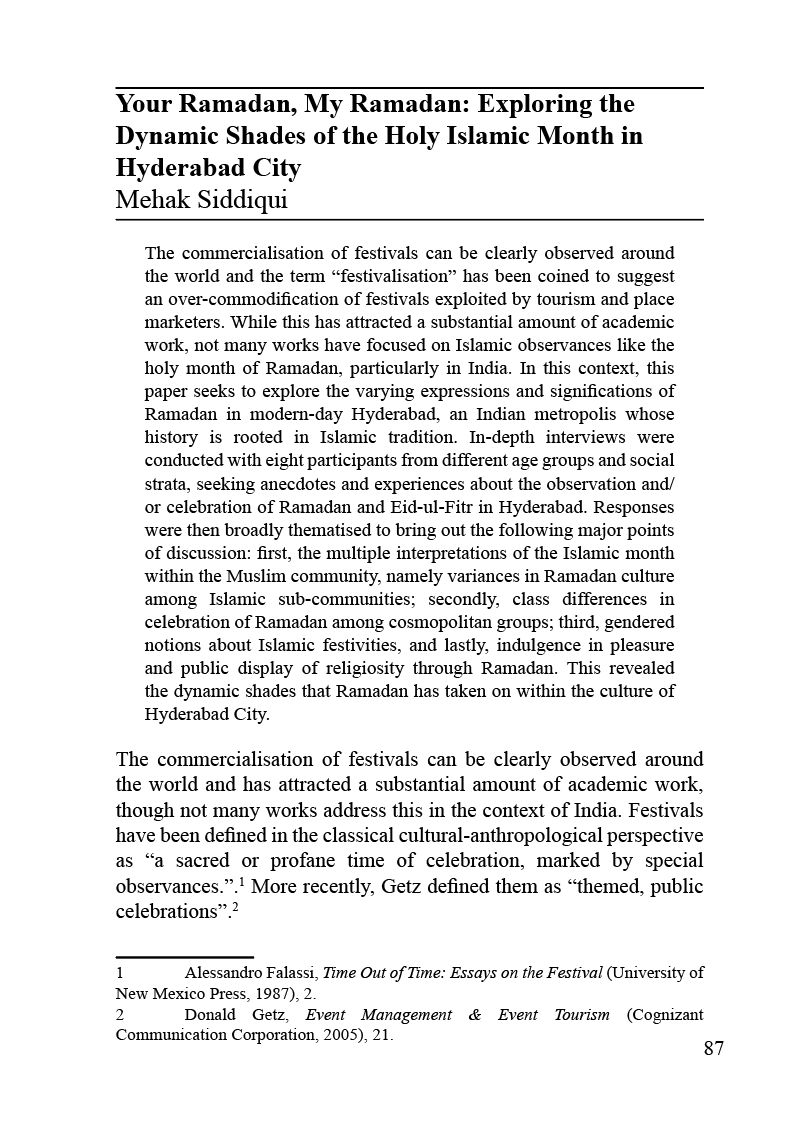Your Ramadan, My Ramadan
Exploring the Dynamic Shades of the Holy Islamic Month in Hyderabad City
DOI:
https://doi.org/10.36399/GroundingsUG.15.119Keywords:
Ramadan, Festivalisation, Hyderabad, Interview Study, Thematic Study, Religious StudiesAbstract
The commercialisation of festivals can be clearly observed around the world and the term “festivalisation” has been coined to suggest an over-commodification of festivals exploited by tourism and place marketers. While this has attracted a substantial amount of academic work, not many works have focused on Islamic observances like the holy month of Ramadan, particularly in India. In this context, this paper seeks to explore the varying expressions and significations of Ramadan in modern-day Hyderabad, an Indian metropolis whose history is rooted in Islamic tradition. In-depth interviews were conducted with eight participants from different age groups and social strata, seeking anecdotes and experiences about the observation and/or celebration of Ramadan and Eid-ul-Fitr in Hyderabad. Responses were then broadly thematised to bring out the following major points of discussion: first, the multiple interpretations of the Islamic month within the Muslim community, namely variances in Ramadan culture among Islamic sub-communities; secondly, class differences in celebration of Ramadan among cosmopolitan groups; third, gendered notions about Islamic festivities, and lastly, indulgence in pleasure and public display of religiosity through Ramadan. This revealed the dynamic shades that Ramadan has taken on within the culture of Hyderabad City.
References
Bakhtin, Mikhail Mikhaĭlovich. Rabelais and His World. Indiana University Press, 1984.
Bhabha, Homi K. The Location of Culture. Routledge, 1994.
Bose, Saikat Kumar. “Centre’s Firefight After Foreign Students In Gujarat Attacked Over Namaz.” NDTV, March 17, 2024. https://www.ndtv.com/india-news/gujarat-university-mob-attacks-foreign-students-over-namaz-inside-gujarat-hostel-5-injured-5254783.
Falassi, Alessandro. Time Out of Time: Essays on the Festival. University of New Mexico Press, 1987.
Frankl, P. J. L. “The Observance of Ramaḍān in Swahili-Land (With Special Reference to Mombasa).” Journal of Religion in Africa 26, no. 4 (1996): 416–34. https://doi.org/10.2307/1581840.
Fiske, John. Reading the Popular. Routledge, 1989.
Getz, Donald. Event Management & Event Tourism. Cognizant Communication Corporation, 2005.
Lefebvre, Henri. 1991. Critique of Everyday Life. Verso Books, 1991.
Karaosmanoglu, Defne. “Nostalgia Spaces of Consumption and Heterotopia Ramadan Festivities in Istanbul.” Culture Unbound: Journal of Current Cultural Research 2 (June 11, 2010). https://doi.org/10.3384/cu.2000.1525.10216283.
Kraidy, Marwan. Hybridity, or the Cultural Logic of Globalization. Temple University Press, 2006. https://doi.org/10.26530/oapen_626979.
Ozlem Sandikci and Sahver Omeraki. “Globalization and Rituals: Does Ramadan Turn Into Christmas?”Advances in Consumer Research 34, (January 2007): 610-615. https://www.researchgate.net/publication/279674339_Globalization_and_rituals_Does_Ramadan_turn_into_Christmas.
Salamandra, Christa. 2004. A New Old Damascus: Authenticity and Distinction in Urban Syria. Indiana University Press.
Schmidt, Leigh Eric. Consumer Rites: The Buying & Selling of American Holidays. Princeton University Press, 1997.
Schmidt, Leonie. “Urban Islamic Spectacles: Transforming the Space of the Shopping Mall during Ramadan in Indonesia.” Inter-Asia Cultural Studies 13 (September 1, 2012): 384–407. https://doi.org/10.1080/14649373.2012.689708.

Downloads
Published
Issue
Section
License
Copyright (c) 2024 Mehak Siddiqui

This work is licensed under a Creative Commons Attribution 4.0 International License.
The CC BY 4.0 license is a Creative Commons license. This is a non-copyleft free license that is good for art and entertainment works, and educational works. It is compatible with all versions of the GNU GPL; however, like all CC licenses, it should not be used on software. People are free to: Share — copy and redistribute the material in any medium or format; Adapt — remix, transform, and build upon the material for any purpose, even commercially. The licensor cannot revoke these freedoms as long as you follow the license terms. But they must conform to the following terms: Attribution — You must give appropriate credit, provide a link to the license, and indicate if changes were made. You may do so in any reasonable manner, but not in any way that suggests the licensor endorses you or your use. No additional restrictions — You may not apply legal terms or technological measures that legally restrict others from doing anything the license permits.
Please check individual article PDF copies to see if any additional restrictions apply.







